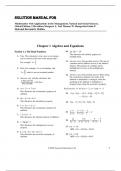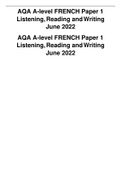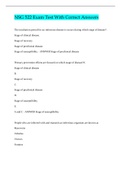Solution Manual for
Mathematics with Applications in the Management, Natural and Social Sciences,
Global Edition, 13th edition Margaret L. Lial Thomas W. Hungerford John P.
Holcomb Bernadette Mullins
Chapter 1 Algebra and Equations
Section 1.1 The Real Numbers 10. 1g(- 20) = - 20
This illustrates the identity property of
1. True. This statement is true, since every integer multiplication.
can be written as the ratio of the integer and 1.
5 11. Answers vary. One possible answer: The sum of
For example, 5 = . a number and its additive inverse is the additive
1
identity. The product of a number and its
2. False. For example, 5 is a real number, and multiplicative inverse is the multiplicative
10 identity.
5= which is not an irrational number.
2 12. Answers vary. One possible answer: When using
the commutative property, the order of the
3. Answers vary with the calculator, but
addends or multipliers is changed, while the
2, 508, 429, 787 grouping of the addends or multipliers is
is the best.
798, 458, 000 changed when using the associative property.
4. 0 + (- 7) = (- 7) + 0 For Exercises 13–16, let p = –2, q = 3 and r = –5.
This illustrates the commutative property of
addition. 13. 3 p 5q 3 2 5(3) 3 2 15
3 13 39
5. 6(t + 4) = 6t + 6 ×4
This illustrates the distributive property. 14. 2 q r 2 3 5 2 8 16
6. 3 + (–3) = (–3) + 3
This illustrates the commutative property of
addition. q+r 3 (5) 2
15. 2
q + p 3 (2) 1
7. (–5) + 0 = –5
This illustrates the identity property of addition.
3q 3(3) 9 9
16.
8. (- 4)g( -41) = 1 3 p 2r 3(2) 2(5) 6 10 4
This illustrates the multiplicative inverse
property. 17. Let r = 3.8.
APR = 12r = 12(3.8) = 45.6%
9. 8 + (12 + 6) = (8 + 12) + 6
This illustrates the associative property of 18. Let r = 0.8.
addition. APR = 12r = 12(0.8) = 9.6%
© 2024 Pearson Education, Ltd. 1
,2 CHAPTER 1 ALGEBRA AND EQUATIONS
19. Let APR = 11. 2(- 3) + ( -32) - 2
APR = 12r
27.
(- 16 )
11 = 12r 64 - 1
11 Work above and below fraction bar. Take roots.
=r
12 2(- 3) + ( -32) - ( -24)
r » .9167%
8- 1
Do multiplications and divisions.
20. Let APR = 13.2.
APR = 12r - 6 - 32 + 12
13.2 = 12r 8- 1
13.2 Add and subtract.
=r - 12 - 32 + 12 - 14
12 2 -7
= 2 = =-1
r = 1.1% 7 7 7
21. 3 - 4 ×5 + 5 = 3 - 20 + 5 = - 17 + 5 = - 12 6 2 - 3 25
28.
22. 8 - (- 4) 2 - (- 12) 6 2 + 13
Take powers and roots.
Take powers first.
36 - 3(5) 36 - 15 21
8 – 16 – (–12) = = =3
Then add and subtract in order from left to right. 36 + 13 49 7
8 – 16 + 12 = –8 + 12 = 4
2040 189 4587
29. , , 27, , 6.735, 47
23. (4 - 5) ×6 + 6 = - 1 ×6 + 6 = - 6 + 6 = 0 523 37 691
2(3 - 7) + 4(8) 187 385
24. 30. , 2.9884, 85 , p , 10,
4(- 3) + (- 3)(- 2) 63 117
Work above and below fraction bar. Do
multiplications and work inside parentheses. 31. 12 is less than 18.5.
12 < 18.5
2(- 4) + 32 - 8 + 32 24
= = = =-4
- 12 + 6 - 12 + 6 - 6 32. –2 is greater than –20.
–2 > –20
25. 8 - 4 2 - (- 12)
Take powers first. 33. x is greater than or equal to 5.7.
8 – 16 – (–12) x ³ 5.7
Then add and subtract in order from left to right.
34. y is less than or equal to –5.
8 – 16 + 12 = –8 + 12 = 4
y£ -5
26. - (3 - 5) - é2 - 32 - 13 ù
( )
ë û 35. z is at most 7.5.
Take powers first. z £ 7.5
–(3 – 5) – [2 – (9 – 13)]
Work inside brackets and parentheses. 36. w is negative.
– (–2) – [2 – (–4)] = 2 – [2 + 4] w<0
= 2 – 6 = –4
37. - 6 < - 2
38. 3.14 < p
39. 3 4 = .75
40. 1 3 > .33
© 2024 Pearson Education, Ltd.
, SECTION 1. 1 THE REAL NUMBERS 3
41. a lies to the right of b or is equal to b.
42. b + c = a
51. - 9 - - 12 = 9 - (12) = - 3
43. c < a < b
52. 8 - - 4 = 8 - (4) = 4
44. a lies to the right of 0
45. (–8, –1) 53. - - 4 - - 1 - 14 = - (4) - - 15
This represents all real numbers between –8 and = - (4) - 15 = - 19
–1, not including –8 and –1. Draw parentheses at
–8 and –1 and a heavy line segment between
54. - 6 - - 12 - 4 = - (6) - - 16 = - 6 - (16) = - 22
them. The parentheses at –8 and –1 show that
neither of these points belongs to the graph.
55. 5 -5
5 __ 5
46. [–1, 10] 5=5
This represents all real numbers between –1 and
10, including –1 and 10. Draw brackets at –1 and 56. - - 4 4
10 and a heavy line segment between them. - 4 4
- 4<4
47. (- 2, 3] 57. 10 - 3 3 - 10
This represents all real numbers x such that 7 -7
–2 < x ≤ 3. Draw a heavy line segment from –2 7 7
to 3. Use a parenthesis at –2 since it is not part of
7=7
the graph. Use a bracket at 3 since it is part of
the graph.
58. 6 - (- 4) -4- 6
10 - 10
10 10
48. [–2, 2) 10 = 10
This represents all real numbers between –2 and
2, including –2, not including 2. 59. - 2 + 8 2- 8
Draw a bracket at –2, a parenthesis at 2, and a 6 -6
heavy line segment between them.
6 6
6=6
49. (- 2, ¥ ) 60. 3 ×- 5 3(- 5)
This represents all real numbers x such that 3 ×–5 - 15
x > –2. Start at –2 and draw a heavy line
3 ×5 15
segment to the right. Use a parenthesis at –2
since it is not part of the graph. 15 = 15
61. 3 - 5 3- 5
50. (–∞, –2] -2 3- 5
This represents all real numbers less than or 2 - 2
equal to –2. Draw a bracket at –2 and a heavy
2>-2
ray to the left.
© 2024 Pearson Education, Ltd.
, 4 CHAPTER 1 ALGEBRA AND EQUATIONS
62. - 5 + 1 -5 +1 78. | 31.1 0.1|| 31.2 | 31.2%
-4 5 +1
79. | 41.9 (31.1) || 10.8 | 10.8%
4 6
4<6 80. |12.5 73.7 || 61.2 | 61.2%
63. When a < 7, a – 7 is negative. 81. 5; 2013, 2014, 2017, 2018, 2019
So a - 7 = - (a - 7) = 7 - a .
82. 5; 2015, 2016, 2017, 2018, 2019
64. When b ≥ c, b – c is positive. 83. 4; 2016, 2017, 2018, 2019
So b - c = b - c .
84. 2; 2018, 2019
Answers will vary for exercises 65–67. Sample answers
are given. Section 1.2 Polynomials
65. No, it is not always true that a + b = a + b . For
1. 11.2 6 » 1, 973,822.685
example, let a = 1 and b = –1. Then,
a + b = 1 + (- 1) = 0 = 0 , but 2. (- 6.54)11 » - 936,171,103.1
a + b = 1 + (- 1) = 1 + 1 = 2 .
6
æ 18 ö
66. Yes, if a and b are any two real numbers, it is 3. ç- ÷ » 289.0991339
è 7ø
always true that a - b = b - a . In general,
a – b = –(b – a). When we take the absolute 7
æ5 ö
value of each side, we get 4. ç ÷ » .0163339967
è9 ø
a - b = - (b - a ) = b - a .
67. For females, the height inequality will be: 5. - 3 2 is negative, whereas ( - 3) 2 is positive. Both
| x - 63.5 |£ 4.4 . - 33 and ( - 3) 3 are negative.
68. For males, the height inequality will be: 6. To multiply 43 and 45 , add the exponents since
| x - 69.0 |£ 4.8
the bases are the same. The product of 43 and
69. 0 3 4 cannot be found in the same way since the
bases are different. To evaluate the product, first
70. 9; 2012, 2013, 2014, 2015, 2016, 2017, 2018, do the powers, and then multiply the results.
2019, 2020
7. 4 2 ×43 = 4 2 +3 = 45
71. 10; 2011, 2012, 2013, 2014, 2015, 2016, 2017,
2018, 2019, 2020
8. (- 4)4 ×(- 4)6 = (- 4)4 + 6 = (- 4)10
72. 4; 2013, 2015, 2016, 2020
9. (- 6) 2 ×(- 6) 5 = (- 6) 2 +5 = (- 6) 7
73. 4; 2011, 2012, 2017, 2018
74. 8; 2011, 2012, 2013, 2014, 2016, 2017, 2018, 10. (2 z) 5 ×(2 z ) 6 = (2 z) 5+ 6 = (2 z)11
2019
7 4×7
11. é(5u ) ù = (5u ) = (5u )
4 28
75. | 73.7 (2.7) || 76.4 | 76.4% ë û
76. | 31.1 12.5 || 43.6 | 43.6% 4
12. (6 y )3 ×éë(6 y )5 ùû 3
= (6 y ) ×(6 y )
20
77. | 41.9 73.7 || 115.6 | 115.6%
= (6 y ) 23
© 2024 Pearson Education, Ltd.







